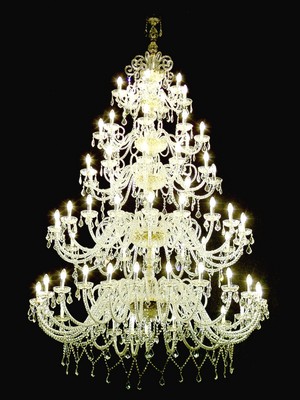Back in the 1970s, crystal chandeliers were very popular room accents for formal living rooms, dining rooms, and foyers. These chandeliers usually consisted of several upright candle light bulbs spaced on a network of “arms” with dozens of crystal pendants graciously draped beneath. As beautiful as these crystal chandeliers were to look at, they were also very timestaking to clean.
I cleaned plenty of those chandeliers over the years; not as the owner of a chandelier but as a college student working her way through school. One thing I learned was that cleaning a chandelier was a time consuming task, and one that can’t be rushed. If you have a crystal chandelier that has lost it’s sparkle due to a build up of dust and grime, these cleaning instructions will show you how it’s done.
Materials for this task include: ladder, old blanket, spray bottle, rinse bucket filled with water, ammonia, water, spray bottle, and an assortment of clean, soft cloths such as tee-shirts.
Step 1: Turn off the light switch to prevent danger of shock.
Step 2: Place a blanket on the ground beneath the chandelier to catch any of the crystals in case they accidentally become detached during the cleaning.
Step 3: Mix up a solution of 1:3 ammonia to water. Rubbing alcohol can be used as a substitute if preferred.
Step 4: Spray the mixture directly onto a dry cloth until dampened. Cleaning only one crystal at a time, carefully wipe the grime off the pendant with the dampened cloth. If the crystal is extremely dirty, the cleaning cloth may have to rinsed off repeatedly in the rinse bucket.
Step 5: When clean, polish dry with a soft, dry cloth. Repeat until all the crystals have been cleaned.
Alternate cleaning tips
Some of my customers had developed their own methods for cleaning a crystal chandelier. One client used a pair of white cotton gloves instead, using one glove to clean and the other to dry. I found this much more time consuming, since the gloves quickly became soiled and much less effective.
Others preferred the “wet clean” method in which the electrical components were covered with baggies to prevent damaging the electrical wiring and then the entire chandelier sprayed with a cleaning solution. The pendants would drip dry, and then could be polished with a dry cloth. The downside with this method is that the frame of the chandelier can become damaged due to contact with the cleaning solution. This method is also a bit messier since excess cleaning solution drips to the ground.
A final solution for cleaning a chandelier is one that I personally preferred for pendants that were coated in greasy grime. This method was to detach the pendants from the chandelier, and wash them in an ammonia solution while sitting at the kitchen table. Most pendants detach very easily, and are easy to rehang once they’ve been cleaned and polished. The advantage to this method is that cleaning pendants it is much easier on the arms when in a sitting position, instead of having to reach upwards from a ladder.


